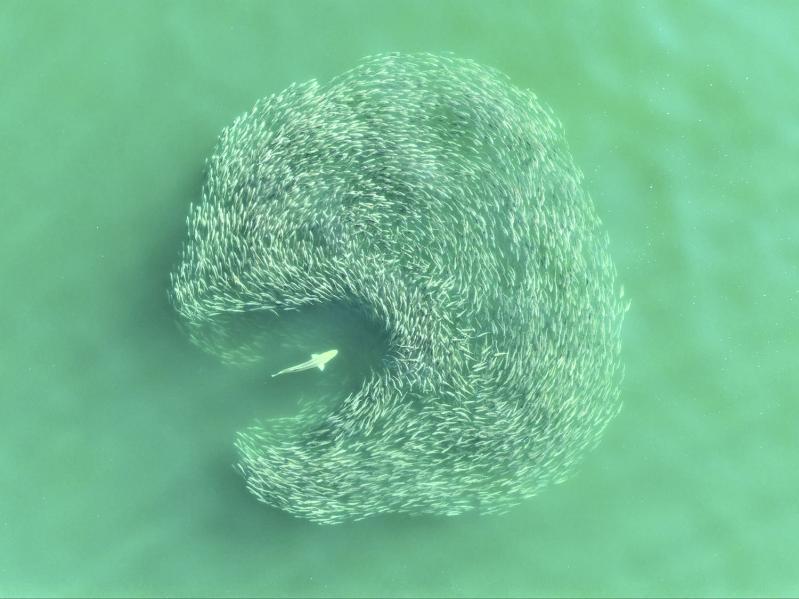If 2023 was the year of the shark on the South Fork, with multiple sightings leading to frequent temporary beach closings, 2024 seems to be the year of the whale, according to Drew Smith, the head lifeguard for East Hampton Village.
“In the last couple of weeks, we’ve noticed much more baitfish going through,” he said. “As a result, there’s been a lot of whale action. Last Monday [Aug. 26] was the first time we had to pull people out of the water to let a whale pass. It was only 20 feet offshore. When a whale passes that close, they tend to animate everybody, from kids to older people. They really change the beach energy. It adds to the whole experience. Everybody sees it as a victory.”
And it is.
“The health of the inshore marine environment is due to decades of conservation measures,” said Frank Quevedo, the executive director of the South Fork Natural History Museum in Bridgehampton. “Environmentalists have been fighting to protect Atlantic menhaden [also known as “bunker”] for decades and we should be proud of the new guidelines that are protecting predatory animals and their food source.”
In 2019, Andrew Cuomo, then the governor of New York, signed a law that restricted “purse seining” in New York State waters within three miles of the beach. Mr. Quevedo explained that a purse seine is a net the length of six city blocks. “When they used to harvest bunker, they would find the school and wipe out the whole stock in one harvest,” he said. That no longer happens. The large whales splashing just offshore are a direct result of their being able once again to find a nice meal there.
Sutton Lynch, a local photographer whose drone shots of marine life have garnered him 41,000 followers on Instagram, says that 99 percent of the whales at our beaches are humpback whales. “Occasionally you’ll see a minke whale, which looks like a large dolphin,” he said. “It’s been incredible to witness this place I grew up in change so quickly in such a positive way. It’s a rare and hopeful story.” Once an East Hampton Town lifeguard, he still uses his drone skills to occasionally call John Ryan Jr., the head lifeguard for the town, to alert him if something concerning in the water is nearing beachgoers.
But while the beach may be getting even cooler for those onshore, the inshore marine life isn’t necessarily helping local fishermen. “The couple of guys left that are packing out the shop are working on the bay side,” said Colin Mather, the owner of the Seafood Shop in Wainscott. “Everything is pretty much status quo for them. The striped bass have gone to deeper, cooler waters. There are some bluefish, weakfish, and fluke around. All normal. The only thing we’ve been seeing a bit in the last couple of years that’s unusual are spots. Spot is a type of fish that’s usually found off Virginia and North Carolina.”
Christopher Paparo, the manager of the marine sciences center at Stony Brook University, said spot may be showing up partly because of the resurgence of oysters, because spot is an oyster-reef-community fish. That said, southern sharks are becoming more common as well. “It’s not that we’re seeing more sharks; we’re seeing different sharks. We don’t catch as many blue sharks as we did years ago. That’s a colder water species. We’ve tagged 17 different species, most close to the beach. But on bunkers, primarily it’s spinner sharks or blacktips,” two species he said that are impossible to distinguish from above. Spinners travel and hunt in schools that can grow to 20 sharks as they move through bunker pods.
“They’re after fish. It’s a media thing with shark attacks,” said Mr. Paparo, a sentiment echoed by every expert interviewed for this article. The stigma faced by sharks, they argue, is simply an ignorant and fantastical depiction from the 1970s movie “Jaws” that’s been difficult to shake. Add irresponsible media outlets magnifying shark bite stories, seemingly ahead of major beach holidays like July Fourth weekend and Labor Day weekend, and the fear is kept fresh. “Sharks go where the fish are. If you’re in the water and there’s a school of fish and you’re splashing around in the school of fish, well, you sound like a school of fish. But think of the millions of people on Long Island beaches during the summer. We’ve only had 13 bites in the last two years. Sharks aren’t attacking people; they’re accidentally biting people. If we didn’t have sharks, we’d have a problem, because that would mean the environment couldn’t support them,” said Mr. Paparo.
He said regulation is important, but even with purse seining restrictions, if the environment were unhealthy, marine life wouldn’t do well. Changing rules on dumping in the ocean, the clean air bills, grants to help homeowners install nitrogen-reducing septic systems, all of it has been worthwhile, he said. “If we don’t do anything, it’s only going to get worse. Everything people pour down the drain makes its way to our bays and oceans. Fertilizers, pesticides. If you can tell me a legit reason why we need green lawns I’d love to hear it,” he said.
Mr. Lynch agrees. “It’s important for people to realize that we can make a difference. Despite all the negative things that we’re doing to the environment, we can change things for the better.” While it’s not always easy to change behavior quickly, Mr. Smith is already noticing a shift in beachgoer habits. “We get people coming down to the beach now just for the whales,” said Mr. Smith. “They grab their morning coffee and then see if the whales are around.”

